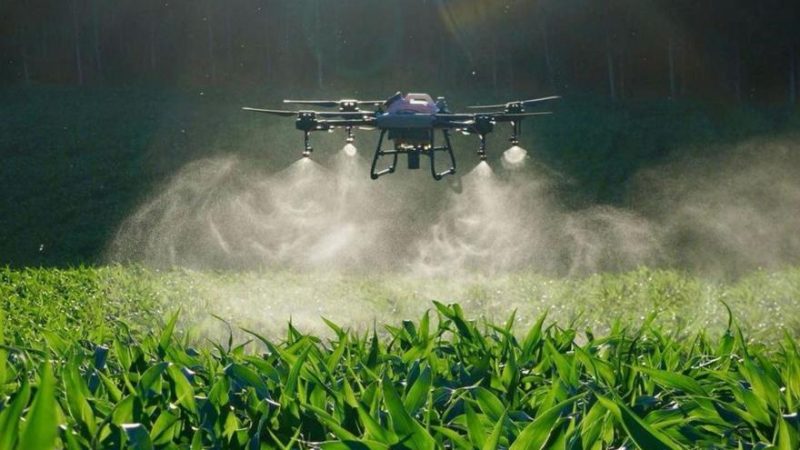What are the benefits of spraying with a drone? Is it more effective and precise than ground rig or helicopter applications? Does it save money on equipment costs and increase yields? Or are the licensing and legal challenges too complicated to navigate?
Chad Gripp founded SweetWater Technologies, a drone-spraying business in Wyanet, Ill., and says the main goal for him and his company is agronomic excellence and making sure they can help farmers make money.
“It needs to work for us, and it has to provide a return on investment for the farmer,” Gripp says. “We need to provide exceptional agronomic advice and agronomic services.”
Although now in the drone sector, Gripp has spent a lot of time spraying hundreds of thousands of acres in a ground rig. The agronomic advice he provides to customers is informed by knowledge he learned in the field.
Gripp started his business in 2022, spraying 32,000 acres with drones. By the end of the 2025 season, he estimates SweetWater Technologies will spray nearly 200,000 acres. He’s also franchising drone businesses in Illinois, Indiana and Missouri.
Drones are gaining momentum, and more farmers are experimenting with them across Illinois and the Midwest.
“What we do is in demand,” Gripp says. “It’s about building relationships with all these farmers and getting on those acres.”
Economic impact
Gripp says economics favor drone application, pointing to self-propelled sprayers that can cost as much as $750,000 compared to drones at $30,000 to $40,000. The ground rig sprayer requires many acres to be covered before the price is made up for.
A pull-behind sprayer with a tractor is cheaper and the farmer can use the tractor for a lot of other applications, but the spraying window is limited by the lower clearance.
Regardless of cost, drones have the advantage in wet conditions, when it would be too muddy for a ground rig to be out in the field. Spraying with a drone causes no soil compaction, and is a noninvasive “precise spraying method,” according to Gripp.
From a coverage standpoint, Gripp notes he’s able to get much closer to the field than a helicopter or plane can.
“We’re always 10 feet off the canopy on almost 100% of the field. We have precise application from an aerial standpoint,” Gripp says.
Beck’s has conducted field-scale trials over the past two years, measuring the effectiveness of various fungicide-spraying methods. Most of these field trials have been conducted in Illinois.
Through this research, Beck’s found drones were the most effective in a fungicide trial on corn, but ground rigs were most effective for soybeans.
According to the data, ROI on two-year fungicide application for corn was highest when using drones:
Drone, $21.11 per acre
Ground rig, $18.13 per acre
Helicopter, $9.84 per acre
However, when looking at soybeans, Beck’s saw an advantage to using a ground rig over a drone in terms of ROI and yield. The ROI and yield averages were:
Ground rig, $4, 77 bushels per acre
Drone, 45 cents, 76.4 bushels per acre
Helicopter, minus $12.56, 75.6 bushels per acre
What can a drone do in a single day?
Gripp provides insight into how a drone business operates, noting that each of his drones can spray between 7 and 9 acres before it needs to return to the ground, refill with chemicals and have the battery replaced.
Trucks transport the drones to the field, equipped with chemicals and a diesel generator to charge batteries between trips. Gripp says the expectation is that the drone is up in the air within a minute to 90 seconds after landing. A single drone sprays between 300 and 500 acres per day. If all drones are operating, that means they’re spraying between 7,500 and 12,500 acres per day.
SweetWater Technologies has a fleet of 25 drones, comprised of two different types of drones — DJI T-40 and EAVision J100, both sourced from Agri Spray Drones. The difference between the two types is that the DJI T-40 flies with radar technology while the EAVision J100 is newer and uses lidar technology. Lidar uses light to measure distance, while radar technology uses radio waves.
Expansion of SweetWater Technologies
Since 2022, Gripp has expanded from four drones and eight interns to 25 drones and 25 interns. Good interns make the difference, and Gripp trains each one to pilot and fill a drone.
“We hire good people. We hire the best interns from some of the best schools,” Gripp says. “Our training is top-notch.”
All interns and individuals flying drones need to meet legal requirements. This includes obtaining their pilot’s license, pesticide license and all Federal Aviation Administration required exemptions.
SweetWater also has developed its own products, sold through its dealer network. One product available is DroneZone, an anti-drift product that helps keep the chemicals being sprayed in the area. This product could be purchased for your own drone, if you do drone spraying yourself.
RELATED NEWS: Pioneering smart agriculture takes centre stage at FRUIT LOGISTICA
Another product, DroneZone Recharged, is the first EPA-registered salicylic-acid long-lasting stress mitigator, and helps with complete plant health, addressing things like heat, cold, insects, disease, wetness, dryness or any other abiotic stress.
“It’s the only EPA-regulated stress mitigator out there this year,” Gripp says. “We’re the only ones in the country that offer that product.”
Gripp says if better technology comes along, SweetWater will adapt. “It just doesn’t end with drones. We’re not a one-hit wonder,” he says. “If there’s something new or better, we are going to adapt to that technology.”
His next goal? Cover a million acres annually within the next three to five years.
Source: FarmProgress




















